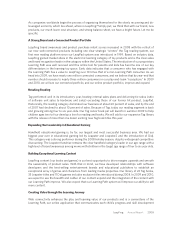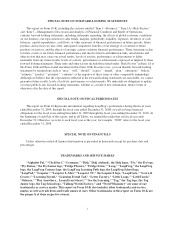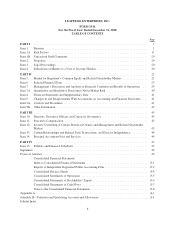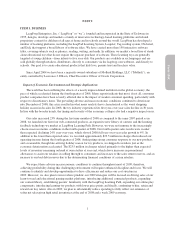LeapFrog 2008 Annual Report Download - page 14
Download and view the complete annual report
Please find page 14 of the 2008 LeapFrog annual report below. You can navigate through the pages in the report by either clicking on the pages listed below, or by using the keyword search tool below to find specific information within the annual report.• In 2008, the majority of our Learning Toys sales came from three product lines: the Fridge Series, a
line of magnetic toys designed for preschoolers and kindergarteners that teaches letter names, letter
sounds and learning songs: the Learn and Groove Series, led by the Learn and Groove musical table
which features bilingual musical learning toys: and Pre-school Games, a line of fast-paced handheld
learning games.
• Clickstart, My First Computer, launched in 2007, introduces computer and preschool skills by
turning any TV into a child’s first computer. We introduced five new Clickstart titles in 2008
including “Cars” by Pixar and “Thomas and Friends” by HIT Entertainment.
• Learning toy products, because of their low price points and focus on younger children, can create
customer entry points to our Reading Solutions and Educational Gaming product families. Our
product strategy centers on products that are designed to “age up” with our child end users.
•LeapFrog Learning Path:
In 2008, we introduced a web-based service, the LeapFrog Learning Path, or Learning Path. Learning
Path is an online tool that helps parents track what their children are learning with our web-connected
products, Tag, Leapster2 and Didj. Learning Path gives our consumers access to a variety of
downloadable content and to online rewards programs that encourage learning. Parents are able to “see
the learning” and gain personalized insight into their child’s learning progress. Learning Path was
introduced in the United States and Canada in 2008. We believe that Learning Path adds value to all of
our products and expands our relationships with existing customers through personalized product
recommendations and relevant information. In addition to the Learning Path, in 2008 we began to
introduce online kids’ content as part of our connected product strategy. Kids, for example, can earn
and redeem rewards for their achievements with Tag, classic Leapster, Leapster2, and Didj. With Didj
they can earn free mini-games; kids can also upload their art files from Leapster2 for printing and
recognition of their friends and family. We expect to expand the content and features of Learning Path
and online play/reward for kids as part of LeapFrog’s connected strategy in 2009 and beyond.
For more information about the risks associated with our new products, particularly LeapFrog’s Learning
Path software, see Part I, Item 1A.—Risk Factors—“Our business depends on highly changeable preferences and
toy trends” and “Our growing strategic focus on web-based products and customer relationship management
may not yield the returns we expect, and may limit the adoption of our products in some international markets”
in this Annual Report on Form 10-K. All references to risk factors throughout this Form 10-K are to risk factors
contained herein.
Competition
Our products compete most directly in the toy industry in the pre-school toy and electronic learning aids
categories, both in the United States and in selected international markets. The educational toy category
continues to attract new entrants as well as new innovative products, and competition is significant. We believe
the principal methods of competition in our industry are performance, features, quality, brand recognition, price
and learning content. We believe our learning toys, reading system, gaming platforms, and the related games and
books, compete favorably on these bases. However, we face the challenge of competitors introducing similar
products or functionality soon after we introduce our new products or product lines, and these competitors may
be able to offer their products at lower prices using cheaper manufacturing or materials, more limited functions,
or higher volume. In addition, many of our direct, indirect and potential competitors have significantly longer
operating histories, greater brand recognition and substantially greater financial, technical and marketing
resources than we do.
Our learning toy product category is important strategically because it introduces parents to the LeapFrog
brand. The educational toy category continues to attract new entrants as well as new innovative products, and
competition is significant. We believe the LeapFrog brand is recognized for quality educational products,
4
























